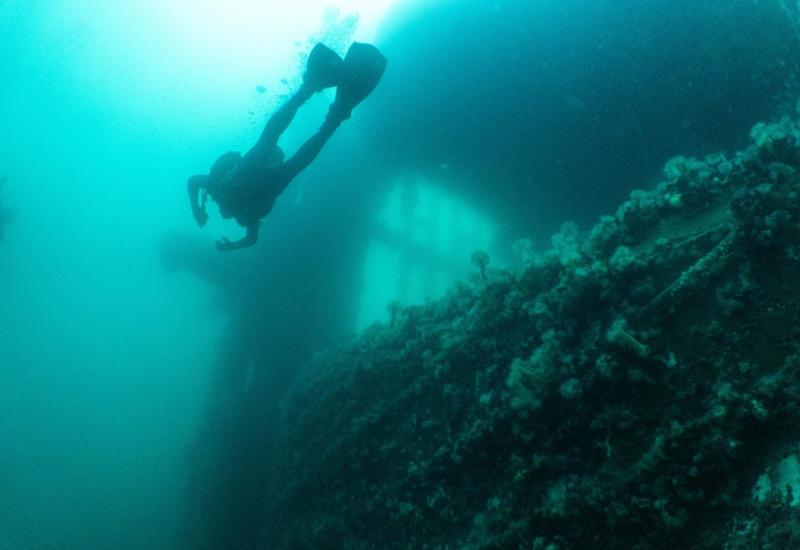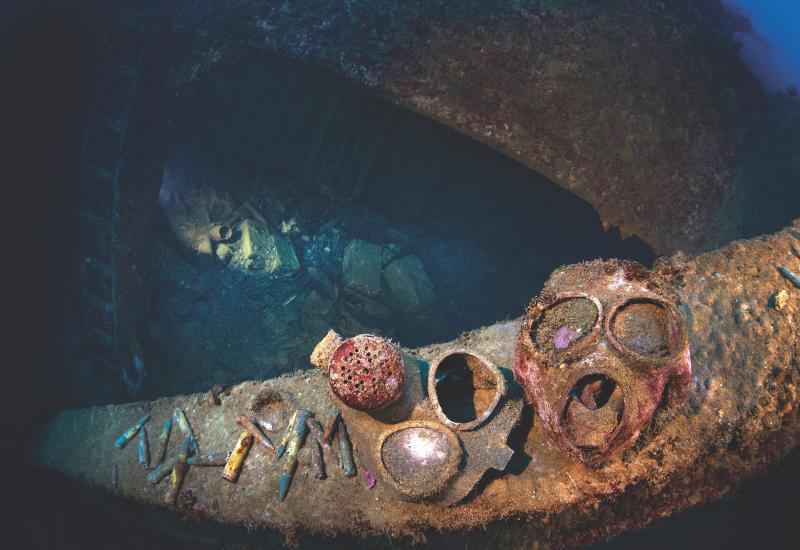The Best Destinations for Wreck Diving
More than 5,000 readers chose their favorite destinations, resorts, operators, liveaboards and more for our 2019 awards. Here we highlight the best destinations for wreck diving, and point out the winning resorts, operators and liveaboards that operate in that area, listed in order of votes received.

Becky Kagan SchottThe 588-foot SS Cedarville’s inverted orientation makes it a favorite for many Great Lakes divers.
1. Great Lakes
For perfectly preserved wrecks—especially wooden sailing ships—there’s no better destination worldwide than the Great Lakes. The largest underwater marine park among the five is Thunder Bay National Marine Sanctuary, found off the city of Alpena—the tip of the pointer finger in the Michigan mitten.
Capt. Brian Anderson, who operates Black Dog Charters in the area, says, “When we go down and see a fully intact wreck with the mast, yardarms and bowsprit all still standing in place, it brings you back in time—as if you were there when they still sailed.”
For tec divers, his pick is the 138-foot Cornelia B. Windiate, but at 180 feet deep, it’s beyond the reach of most. For everyone else, he steers toward the SS Cedarville, whose bow is in 30 feet. Best of all, it’s 588 feet long.
2. North Carolina
Most divers who can lay claim to logging the Outer Banks haven’t journeyed beyond the reach of a dayboat, which means they’re missing out on a handful of rarely seen sites.
Take Proteus, a 406-foot passenger liner. Olympus Dive Center, based in Morehead City, North Carolina, visits the site only once a month in summer. The shop offers what they call extended day trips, venturing three hours from shore to sites such as the Proteus, with the full schedule found online.
“The biggest, most remarkable thing is that the propeller remains, because nearly all the others have been salvaged for their copper,” says Chris Mason, a divemaster with Olympus.
These longer trips also venture to the 401-foot Cassimir tanker and the 312-foot Normannia freighter.
3. Florida
“Ask a diver to picture a wreck, and they picture the Duane,” says Louis Crispino, instructor with Quiescence Diving Services, based in Key Largo, Florida.
He’s talking about the USCGC Duane, an intact, upright, 327-foot-long ship that sits in clear, warm water with its deck at 100 feet. Divers drop down and can easily distinguish the outline, making it one of the top wreck dives in the Florida Keys, along with the Eagle, Spiegel Grove, Thunderbolt and more.
But Florida’s wreck cred covers both coasts. There are numerous purpose-sunk wrecks perfect for divers up the Atlantic Coast, with wreck treks that allow you to ride the current and hit multiple sites off Fort Lauderdale and Palm Beach County.
In the Gulf of Mexico, the granddaddy of them all is the Mighty O. The Oriskany spans a whopping 911 feet—this aircraft carrier was purpose-sunk off Pensacola in the Panhandle to 212 feet.
Readers Picks
Operators
Rainbow Reef, Key Largo
Ocean Divers, Key Largo
Horizon Divers, Key Largo
Dive Key West
Key Dives, Islamorada
Sea Experience, Fort Lauderdale
Quiescence, Key Largo
Pura Vida Divers, Riviera Beach
Florida Keys Dive Center, Islamorada
American Dream Dive Charters, Fort Lauderdale
Resorts
Amy Slate’s Amoray Dive Resort,Key Largo
Hawks Cay Resort and Marina, Duck Key
Looe Key Reef Resort, Ramrod Key
Liveaboards
Juliet Sailing and Diving, Miami
Blue Iguana Charters, Key Largo
4. Cayman Islands

Greg PiperA 2017 tropical storm pushed the Kittiwake closer to a nearby reef.
The wrecks of the Cayman Islands make for impressive dives—but what’s more impressive is how well the sites cater to beginners ready to tackle the wreck diver certification.
The USS Kittiwake was sunk in 2011. It might lack sponge and other marine growth, but it’s benefited from the newest techniques and technology in its sinking. The Kittiwake stands 251 feet long, and has had so many doors, hatches, bulkheads and sections of floor removed that it holds the reputation as one of the safest, largest wrecks for penetration diving—and, under the watchful eye of an instructor, taking your first-ever penetration swim. There are more than a dozen shipwrecks in the Cayman Islands, including favorites such as the Doc Paulson off Grand Cayman and Captain Keith Tibbetts off Cayman Brac.
Readers Picks
Resorts
Little Cayman Beach Resort
Sunset House, Grand Cayman
Brac Reef Beach Resort, Cayman Brac
Operators
Ocean Frontiers, Grand Cayman
Reef Divers, Little Cayman
Liveaboard
Cayman Aggressor IV (replaced by Cayman Aggressor V)

Pete Mesley/Lust4Rust.coTruk Lagoon's Rio de Janeiro Maru still carries supplies
5. Truk Lagoon
No sunken fleet has the power to convert a diver into a wreck aficionado like that of Truk Lagoon.
Just ask Brandi Mueller, captain of Truk Odyssey.
“Truk has this reputation as being deep and dark, so I wasn’t really all that interested in these wrecks—but I got here and was blown away,” she says of the Imperial Japanese ships, such as the Fujikawa Maru, the Rio de Janeiro Maru and more than 30 others, that became reefs following Operation Hailstone in 1944. More than 4,500 men were killed during the attack, and 400 more lives were claimed inside as the ships filled with water.
“The human connection with these ships being war graves is very powerful,” Mueller says. But beyond the history, the ships have become living reefs.
Mueller adds, “Even divers who don’t think they like wreck diving are surprised by how covered in marine life the wrecks are. The word ‘shipreefs’ is a great description. There really is something for everyone here.”
Readers Pick
Liveaboard
Truk Odyssey
6. Hawaii
Oahu is one of the most easy-to-reach destinations offering divers the experience of dropping in on an underwater Corsair plane.
“It’s well-preserved but covered in growth,” says Doug Perrine, a Hawaii-based photographer, of this World War II wreck ditched in 1948.
You’ll find it in the sand at 115 feet, 3 miles from the southeast coast of the island. The tail fins, propeller and cockpit all remain, now sporting a layer of marine life, from bright-red sponges to encrusting corals.
It won’t fly again, but it’s thriving in its new life.
Perrine says, “There are always fish around it and in it.”
Readers Picks
Operators
Jack’s Diving Locker, Big Island, Hawaii
Kona Honu Divers, Big Island, Hawaii
Maui Dive Shop, Hawaii
Scuba Shack, Maui, Hawaii
Big Island Divers, Hawaii
Kona Diving Company, Big Island, Hawaii
Liveaboard
Kona Aggressor II, Big Island, Hawaii

Greg PiperEngine trouble led to a relatively peaceful end for this Corsair plane in 1948, keeping it intact for divers in Oahu today.
7. Red Sea
The SS Thistlegorm might receive most of the fanfare, but it’s not the only wreck off Egypt. Venture to Brothers Islands, 42 miles from the coast, and you’ll find the 246-foot Aida and the 451-foot Numidia wrecks—unique in that both rest on the coral wall of an atoll, pitched at a dramatic angle of roughly 80 degrees. The deepest point of both can be found in 180 feet of water, with the Aida’s bow at 90 feet and the Numidia starting in 60 feet. Both are now coated in bright-pink soft corals, having become reef just as much as the corals flanking either side.
Readers Pick
Liveaboard
Red Sea Aggressor II
8. British Virgin Islands
The BVI won top honors in the wreck diving category for the Caribbean thanks to its menu of ships well-suited to all divers, even those fresh out of the gate.
“The wrecks here are very recreational diver friendly,” says Kevin Purdy, of All-Star Liveaboards, operator of the Cuan Law trimaran.
The RMS Rhone, sunk during an 1867 hurricane, is the most famous of the lot, and the real treat for liveaboard divers is the night dive here. Split into two, the ship is now a habitat for green sea turtles, moray eels, and a crew of other critters.
Purdy says, “Squid, crabs, octopuses coming to hunt; the place comes alive at night.”
The weeklong charters also include dives on the 246-foot Chikuzen refrigeration ship, the recently sunk Kodiak Queen—a project with Richard Branson at the helm—and the three wrecks in Cooper Island’s Wreck Alley.
Readers Pick
Liveaboard
Cuan Law, British Virgin Islands
9. Palau
Maybe it’s because the wall and shark dives are so stellar that divers tend to overlook Palau as a wreck destination—and yet, it’s home to more than 60 World War II wrecks. For some, it’s a bonus that many of the ships, such as the Iro Maru, are just a 10-minute boat ride from Palau’s main harbor. The Iro Maru starts with masts at 30 feet and sits in the sand at 130 feet, with forward and aft guns still prominent. The lineup also includes the 522-foot Amatsu Maru oil tanker, the largest wreck in Palau, and two planes: a Zero fighter and a Jake seaplane.
Readers Picks
Resort
Palau Pacific Resort
Operator
Sam’s Tours, Palau
Liveaboards
Palau Aggressor II/Rock Islands Aggressor
10. Bahamas
Movie directors favor this island nation for the same reasons it should be on your travel list. Sure, the destination has gin-clear water, but better still is the collection of wrecks—some 40 strong—found along the islands that give divers almost infinite choice, from a shallow cement-hulled cargo steamer off Bimini Island to the M/V Comberbach freighter, with a bus sitting on its top deck, found off Long Island. Off Nassau, options include the 130-foot Willaurie freighter, a Cessna, and the crème de la crème, the 200-foot Ray of Hope, which gives divers a wreck, a wall and a shark experience all on one tank.
Readers Picks
Operator
Stuart Cove’s Dive Bahamas
Liveaboards
Aqua Cat, Bahamas
Blackbeard’s Cruises, Bahamas
Bahamas Master
Bahamas Aggressor
Caribbean and Atlantic
- British Virgin Islands
- Aruba
- Cayman Islands
- Bahamas
- St. Croix, U.S.Virgin Islands
North America
- Great Lakes
- North Carolina
- British Columbia, Canada
- Florida
- California
Pacific and Indian
- Truk Lagoon, Micronesia
- Red Sea
- Hawaii
- Bali, Indonesia
- Palau
For more: /readerschoice










